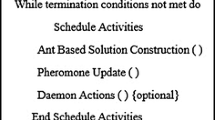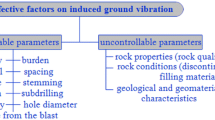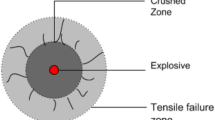Abstract
Blasting operations create significant problems to residential and other structures located in the close proximity of the mines. Blast vibration is one of the most crucial nuisances of blasting, which should be accurately estimated to minimize its effect. In this paper, an attempt has been made to apply various models to predict ground vibrations due to mine blasting. To fulfill this aim, 112 blast operations were precisely measured and collected in one the limestone mines of Iran. These blast operation data were utilized to construct the artificial neural network (ANN) model to predict the peak particle velocity (PPV). The input parameters used in this study were burden, spacing, maximum charge per delay, distance from blast face to monitoring point and rock quality designation and output parameter was the PPV. The conventional empirical predictors and multivariate regression analysis were also performed on the same data sets to study the PPV. Accordingly, it was observed that the ANN model is more accurate as compared to the other employed predictors. Moreover, it was also revealed that the most influential parameters on the ground vibration are distance from the blast and maximum charge per delay, whereas the least effective parameters are burden, spacing and rock quality designation. Finally, in order to minimize PPV, the developed ANN model was used as an objective function for imperialist competitive algorithm (ICA). Eventually, it was found that the ICA algorithm is able to decrease PPV up to 59% by considering burden of 2.9 m, spacing of 4.4 m and charge per delay of 627 Kg.




















Similar content being viewed by others
References
Ambraseys N (1968) Rock mechanics in engineering practice. Wiley, Hoboken
Armaghani DJ, Hajihassani M, Mohamad ET, Marto A, Noorani S (2014) Blasting-induced flyrock and ground vibration prediction through an expert artificial neural network based on particle swarm optimization. Arab J Geosci 7(12):5383–5396
Armaghani DJ, Momeni E, Abad SVANK, Khandelwal M (2015) Feasibility of ANFIS model for prediction of ground vibrations resulting from quarry blasting. Environ Earth Sci 74(4):2845–2860
Armaghani DJ, Faradonbeh RS, Rezaei H, Rashid ASA, Amnieh HB (2018a) Settlement prediction of the rock-socketed piles through a new technique based on gene expression programming. Neural Comput Appl 29(11):1115–1125
Armaghani DJ, Hasanipanah M, Amnieh HB, Mohamad ET (2018b) Feasibility of ICA in approximating ground vibration resulting from mine blasting. Neural Comput Appl 29(9):457–465
Atashpaz-Gargari E, Lucas C (2007) Imperialist competitive algorithm: an algorithm for optimization inspired by imperialistic competition. In: 2007 IEEE congress on evolutionary computation, Singapore, pp 4661–4667
Bureau of Indian Standard (1973) Criteria for safety and design of structures subjected to underground blast
Chen G, Fu K, Liang Z, Sema T, Li C, Tontiwachwuthikul P, Idem R (2014) The genetic algorithm based back propagation neural network for MMP prediction in CO 2-EOR process. Fuel 126:202–212
Dindarloo SR (2015) Prediction of blast-induced ground vibrations via genetic programming. Int J Min Sci Technol 25(6):1011–1015
Dowding CH, Dowding C (1996) Construction vibrations. Prentice Hall, Upper Saddle River
Dowding CH, Hryciw RD (1986) A laboratory study of blast densification of saturated sand. J Geotech Eng 112(2):187–199
Duvall WI, Fogelson DE (1962) Review of criteria for estimating damage to residences from blasting vibrations. US Department of the Interior, Bureau of Mines
Duvall WI, Petkof B (1958) Spherical propagation of explosion-generated strain pulses in rock. Bureau of Mines, Bangalore
Dyskin AV, Basarir H, Doherty J et al (2018) Computational monitoring in real time: review of methods and applications. Geomech Geophys Geo-energ Geo-resour 4:235. https://doi.org/10.1007/s40948-018-0086-6
Faradonbeh RS, Monjezi M (2017) Prediction and minimization of blast-induced ground vibration using two robust meta-heuristic algorithms. Eng Comput 33(4):835–851
Fişne A, Kuzu C, Hüdaverdi T (2011) Prediction of environmental impacts of quarry blasting operation using fuzzy logic. Environ Monit Assess 174(1–4):461–470
Ghasemi E, Ataei M, Hashemolhosseini H (2013) Development of a fuzzy model for predicting ground vibration caused by rock blasting in surface mining. J Vib Control 19(5):755–770
Gokceoglu C, Zorlu K (2004) A fuzzy model to predict the uniaxial compressive strength and the modulus of elasticity of a problematic rock. Eng Appl Artif Intell 17(1):61–72
Grima MA, Verhoef P (1999) Forecasting rock trencher performance using fuzzy logic. Int J Rock Mech Min Sci 36(4):413–432
Hajihassani M, Armaghani DJ, Marto A, Mohamad ET (2015a) Ground vibration prediction in quarry blasting through an artificial neural network optimized by imperialist competitive algorithm. Bull Eng Geol Env 74(3):873–886
Hajihassani M, Armaghani DJ, Monjezi M, Mohamad ET, Marto A (2015b) Blast-induced air and ground vibration prediction: a particle swarm optimization-based artificial neural network approach. Environ Earth Sci 74(4):2799–2817
Hasanipanah M, Monjezi M, Shahnazar A, Armaghani DJ, Farazmand A (2015) Feasibility of indirect determination of blast induced ground vibration based on support vector machine. Measurement 75:289–297
Hasanipanah M, Faradonbeh RS, Amnieh HB, Armaghani DJ, Monjezi M (2017) Forecasting blast-induced ground vibration developing a CART model. Eng Comput 33(2):307–316
Hosseini S, Khaled AA (2014) A survey on the Imperialist Competitive Algorithm metaheuristic: implementation in engineering domain and directions for future research. Appl Soft Comput 24:1078–1094
Hudaverdi T (2012) Application of multivariate analysis for prediction of blast-induced ground vibrations. Soil Dyn Earthq Eng 43:300–308
Iphar M, Yavuz M, Ak H (2008) Prediction of ground vibrations resulting from the blasting operations in an open-pit mine by adaptive neuro-fuzzy inference system. Environ Geol 56(1):97–107
Khandelwal M, Singh T (2006) Prediction of blast induced ground vibrations and frequency in opencast mine: a neural network approach. J Sound Vibration 289(4–5):711–725
Khandelwal M, Singh T (2007) Evaluation of blast-induced ground vibration predictors. Soil Dyn Earthq Eng 27(2):116–125
Khandelwal M, Singh T (2009) Prediction of blast-induced ground vibration using artificial neural network. Int J Rock Mech Min Sci 46(7):1214–1222
Khandelwal M, Kankar P, Harsha S (2010) Evaluation and prediction of blast induced ground vibration using support vector machine. Mining Sci Technol (China) 20(1):64–70
Khandelwal M, Kumar DL, Yellishetty M (2011) Application of soft computing to predict blast-induced ground vibration. Eng Comput 27(2):117–125
Khandelwal M, Ranjith PG (2017) Study of crack propagation in concrete under multiple loading rates by acoustic emission. Geomech Geophys Geo-energ Geo-resour 3:393–404. https://doi.org/10.1007/s40948-017-0067-1
Khandelwal M, Armaghani DJ, Faradonbeh RS, Yellishetty M, Majid MZA, Monjezi M (2017) Classification and regression tree technique in estimating peak particle velocity caused by blasting. Eng Comput 33(1):45–53
Kosko B (1992) Neural networks and fuzzy systems: a dynamical systems approach to machine intelligence/book and disk. Prentice Hall, Upper Saddle River
Li DT, Yan JL, Zhang L (2012) Prediction of Blast-Induced Ground Vibration Using Support Vector Machine by Tunnel Excavation. Appl Mech Mater 170–173:1414–1418. https://doi.org/10.4028/www.scientific.net/amm.170-173.1414
Mehrdanesh A, Monjezi M, Sayadi AR (2018) Evaluation of effect of rock mass properties on fragmentation using robust techniques. Eng Comput 34(2):253–260
Mohamadnejad M, Gholami R, Ataei M (2012) Comparison of intelligence science techniques and empirical methods for prediction of blasting vibrations. Tunn Undergr Space Technol 28:238–244
Mohamed MT (2011) Performance of fuzzy logic and artificial neural network in prediction of ground and air vibrations. Int J Rock Mech Min Sci 48(5):845
Monjezi M, Ahmadi M, Sheikhan M, Bahrami A, Salimi A (2010) Predicting blast-induced ground vibration using various types of neural networks. Soil Dyn Earthq Eng 30(11):1233–1236
Monjezi M, Ghafurikalajahi M, Bahrami A (2011) Prediction of blast-induced ground vibration using artificial neural networks. Tunn Undergr Space Technol 26(1):46–50
Monjezi M, Hasanipanah M, Khandelwal M (2013a) Evaluation and prediction of blast-induced ground vibration at Shur River Dam, Iran, by artificial neural network. Neural Comput Appl 22(7–8):1637–1643
Monjezi M, Mehrdanesh A, Malek A, Khandelwal M (2013b) Evaluation of effect of blast design parameters on flyrock using artificial neural networks. Neural Comput Appl 23(2):349–356
Monjezi M, Baghestani M, Faradonbeh RS, Saghand MP, Armaghani DJ (2016) Modification and prediction of blast-induced ground vibrations based on both empirical and computational techniques. Eng Comput 32(4):717–728
Nateghi R (2011) Prediction of ground vibration level induced by blasting at different rock units. Int J Rock Mech Min Sci 48(6):899–908
Neaupane KM, Achet SH (2004) Use of backpropagation neural network for landslide monitoring: a case study in the higher Himalaya. Eng Geol 74(3):213–226
Rahul KM, Rai R, Shrivastva BK (2015) Evaluation of dump slope stability of a coal mine using artificial neural network. Geomech Geophys Geo-energ Geo-resour 1:69–77
Simpson PK (1990) Artificial neural systems: foundations, paradigms, applications, and implementations. Pergamon, Oxford
Singh T, Singh V (2005) An intelligent approach to prediction and control ground vibration in mines. Geotech Geol Eng 23(3):249–262
Trippi RR, Turban E (1992) Neural networks in finance and investing: using artificial intelligence to improve real world performance. McGraw-Hill Inc, New York
Verma A, Singh T (2011) Intelligent systems for ground vibration measurement: a comparative study. Eng Comput 27(3):225–233
Verma AK, Sirvaiya A (2016) Comparative analysis of intelligent models for prediction of Langmuir constants for CO2 adsorption of Gondwana coals in India. Geomech Geophys Geo-energ Geo-resour 2:97–109. https://doi.org/10.1007/s40948-016-0025-3
Author information
Authors and Affiliations
Corresponding author
Additional information
Publisher's Note
Springer Nature remains neutral with regard to jurisdictional claims in published maps and institutional affiliations.
Rights and permissions
About this article
Cite this article
Rezaeineshat, A., Monjezi, M., Mehrdanesh, A. et al. Optimization of blasting design in open pit limestone mines with the aim of reducing ground vibration using robust techniques. Geomech. Geophys. Geo-energ. Geo-resour. 6, 40 (2020). https://doi.org/10.1007/s40948-020-00164-y
Received:
Accepted:
Published:
DOI: https://doi.org/10.1007/s40948-020-00164-y




